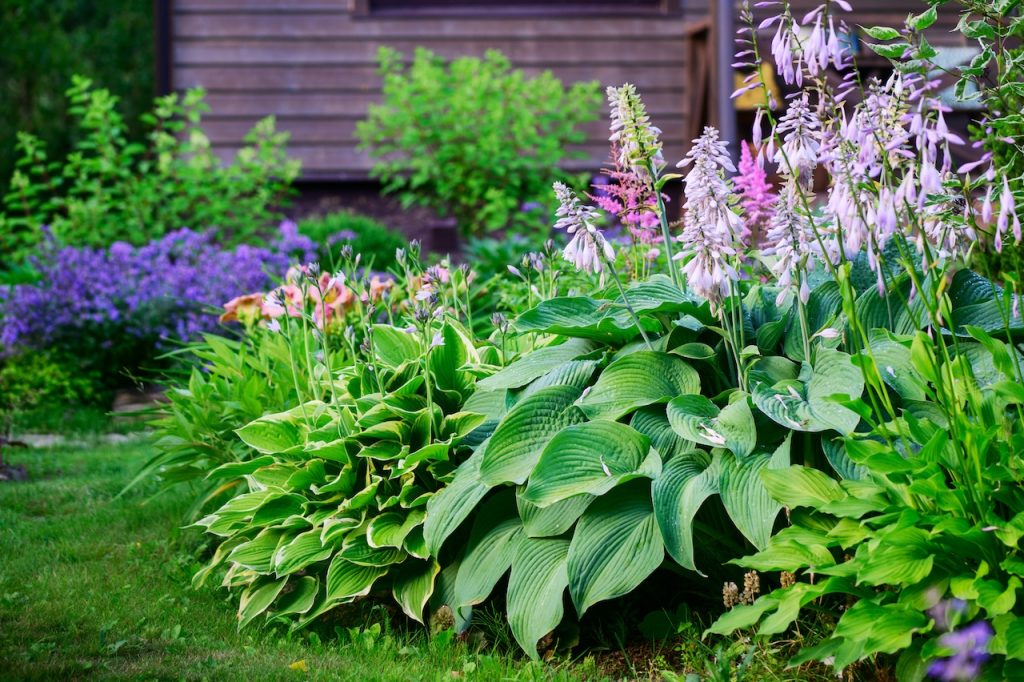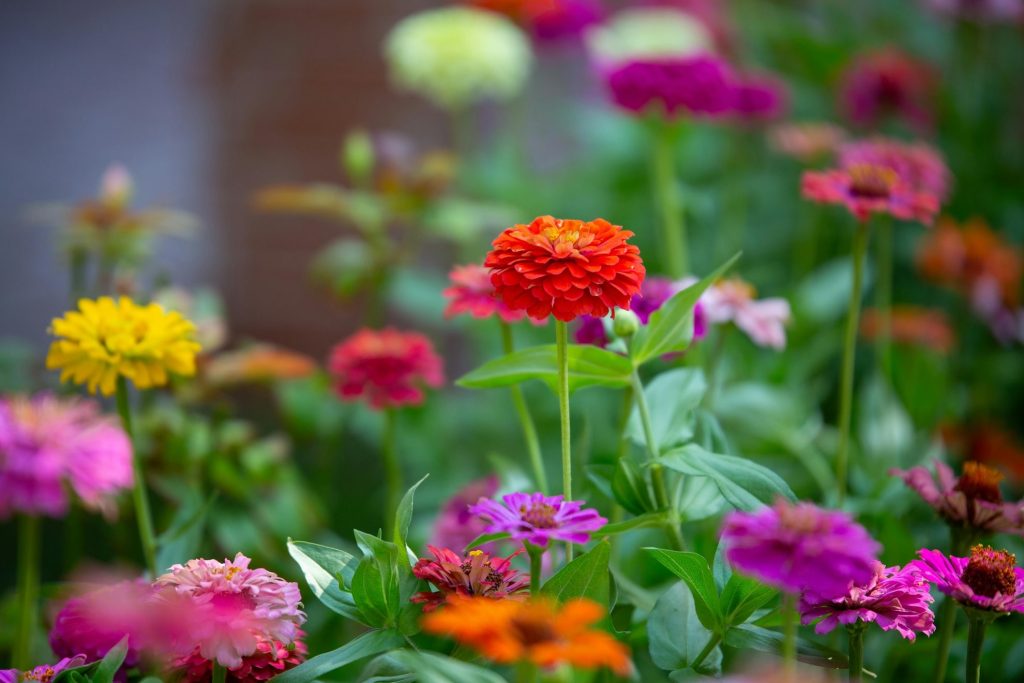
The value of gardening with perennials is hard to overstate. There is definitely an ease to planting once and then enjoying the beauty of what you have created year after year. Whether you are a homeowner who wants curb appeal without the constant upkeep or a property manager seeking durable, seasonal color with easy maintenance, you can find value in planting a perennial garden. You can get lasting beauty with decreased watering, lower replanting costs, and stronger root systems. To enjoy all of these positives, however, you need to do some upfront planning and there is no better time to take that on than in late fall.
Let’s take a look at how to plan, plant, and care for a perennial garden that will thrive in Midwest conditions with minimal upkeep. You can then plan your 2026 perennial beds with Tracer Pool and Landscape.
Perennials have higher upfront costs when compared with annuals, but if the correct plants are chosen for your specific soil, water, and light conditions and then properly maintained, you can enjoy your perennials for years and years. Over time, this upfront cost and planning will save you time and money over and over again.
Perennials are plants that are planted in the ground and grow and bloom seasonally, die back in the fall, go dormant in the winter, and then reappear in the spring to experience the growth cycle once again. Basically, they come back year after year.
Annuals, on the other hand, much as the name suggests need to be planted annually because they die at the end of the season and never return. This means you need to re-buy and re-plant annuals every spring.
Perennials tend to be more suited to the local climate, which is why they come back year after year. Some annuals that are planted in the Midwest, where harsher winters are experienced, are actually perennials in warmer, more temperate climates. So, overall, perennials are more suited to local conditions and are often native to the area in which they are planted.
Using perennials as the structural basis for your garden design helps you plan a thoughtful and permanent color strategy and maintenance plan for your garden that can then be supplemented with a limited number of annual accents that can give you variety and color. This mixed-bed strategy can save you both time and money and give you the value of perennials and the drama of annuals.

To have a garden that looks good all year, you need a planning strategy before you invest in your perennial plants.
Your perennial garden design starts with mapping the sun and shade areas of your yard. Plants need three basic things to flourish–sun, water, and soil. Knowing where sun plants and shade or part-shade plants will thrive in your yard is key to gardening with perennials.
Observe your yard from sun up to sun down and map out where the sun hits the brightest and hottest and where shade is most prevalent. For reference, south facing areas without a lot of tree cover will get the most sun. East facing or west facing areas that have varying degrees of cover from trees or buildings will get partial sun exposure, while areas with heavy cover or facing north or both will be shaded.
Planning a perennial color calendar to see when each plant will be in full bloom, so you can plan to have blooming and color all season long in succession. Choose a group of plants that bloom in early to late spring and then those that will bloom in early summer. Then choose other groups that bloom at the height of summer, late summer, and into the early fall. In this way, you will have color and interest throughout the growing season. With a perennial garden you will not have everything blooming at once, but the goal is to have something of interest blooming at all times. You can then add in annuals to fill in any gaps and add accents to your perennial scheme.
Planning your bed also means testing your soil to see what types of plants will thrive in the soil you have. Also avoid overcrowding your plants by spacing them out properly.
With low-maintenance a driving factor in planting a perennial garden, choosing plants that thrive in your climate and conditions helps you achieve this minimal upkeep ideal. This can be trickier for Midwest yards, so choose plants that are proven to thrive in a Midwest climate.
Full sun perennials that thrive well in the Midwest include:
Perennials for shade include:
Native plants are often more resilient and usually support local pollinators, which reduces fertilizer and pesticide needs. These native and pollinator-friendly perennials include:
No one wants to be stuck constantly watering their plants and worrying if they are getting enough water to survive and thrive. This makes planting drought-tolerant perennials a top consideration.
Another problem that can easily compromise your perennial garden are animals that may find what you have planted good eating. Deer can be an especially difficult problem. By planning deer-resistant plants you can avoid this pitfall, but there are no guarantees.
Even though most plants go dormant in the winter, it does not mean you can’t have interest in your garden year-round. By planning grasses, seed heads, and bark into your perennial structure you can have off-season texture outside of the growing season.
You can ask our designers at Tracer Pool and Landscape for a custom, low-maintenance plant palette.

Perennial bed preparation in fall is one way you can set your perennial garden up for success in the spring. This includes mulching, soil improvement and edging.
One sure way to improve your soil is by adding compost or other organic matter. Make sure this soil refresh is done at a depth of 8 to 10 inches. You also want to avoid compaction in your soil which impedes moisture saturation and prevents strong root growth. Testing your soil can also help you understand and identify your soil’s specific needs.
Creating clean lines for definition and a growth boundary is best done with a physical barrier or edging that can be made up of steel or even low growing plants.
Mulching perennials the right way can help keep your plants healthy and cut down on weed growth. Prepare the area before adding mulch by clearing away weeks, debris, and old mulch. Spread the new mulch at a depth of 2 to 4 inches. Avoid placing the mulch too close to the base of your trees or shrubs to prevent disease and rot.
When it comes to low maintenance perennials, a few smart tactics go a long way in reducing watering and weeding. Employing these several strategies can keep your perennial garden maintenance at a minimum.
You can reduce watering for your perennial garden by using drip lines, which deliver water directly to your plants’ roots. You can create a simple drip irrigation system with a network of tubing, emitters, and valves. Drip irrigation can reduce weeds while promoting healthier plant growth.
Again, with proper mulching and smart edging you can improve your garden’s look and control sprawl. You can also employ other weed control methods such as weed barriers, which are often heavy-duty landscape fabric. You can also use cardboard or newspaper for a more biodegradable option.
Your care calendar also includes times when it is best for dividing perennials and when and how to do a refresh, like deadheading and pruning.
Deadheading removes spent flowers, which can encourage additional flower growth. However, by leaving the seed heads you allow for self-seeding, winter interest, and even some food for your backyard wildlife. Often it is best to stop deadheading in late summer.
Dividing perennials can help control their size and improve their health. It can rejuvenate plants that have become overcrowded and is also a cost-effective way to increase the number of plants in your garden. Spring-flowering perennials should be divided in the fall while fall-flowering perennials should be divided in early spring. You should never divide any plants that are actively blooming or on hot, sunny days.
Overall, a quick season cadence for maintaining your perennial garden includes:
You can book a seasonal refresh or division service with Tracer Pool and Landscape to help you with your garden maintenance.
Having a professional, like Tracer Pool and Landscape, build a low-maintenance plan for you can help you avoid gaps, lower your risk of an out of scale design as well as poor color timing. Tracer designs landscapes that maximize bloom succession for color and interest along with helping you have a garden with easy upkeep. Tracer can design, install, and provide seasonal refresh services for you to maximize your garden’s potential. Contacting Tracer to set up a site assessment, plant selection guidance, or a maintenance plan can help make your backyard garden dreams come true.
Perennial beds that last are planned well, taking into consideration what will thrive in the sun, soil, and moisture conditions in your yard. But, overall, the benefits of gardening with perennials include saving you both time and money on an outdoor space that will be beautiful year after year. You can start your planning now for a spring install by calling the garden design experts at Tracer Pool and Landscape.
A: Mature size that fits the space, drought tolerance, disease resistance, and minimal staking or division needs.
A: Yes, by layering early, mid, and late-season bloomers and adding foliage interest.
A: A 2 to 3-inch mulch layer reduces weeds and keeps moisture stable, which cuts ongoing care.
A: Typically, every 3–5 years, or when clumps decline or crowd neighbors.
A: They’re often more resilient and support local pollinators, reducing fertilizer and pesticide needs.